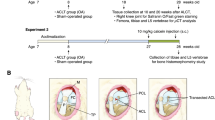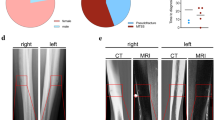Abstract
The pathology of medial tibial stress syndrome (MTSS) is unknown. Studies suggest that MTSS is a bony overload injury, but histological evidence is sparse. The presence of microdamage, and its potential association with targeted remodeling, could provide evidence for the pathogenesis of MTSS. Understanding the pathology underlying MTSS could contribute to effective preventative and therapeutic interventions for MTSS. Our aim was to retrospectively evaluate biopsies, previously taken from the painful area in athletes with MTSS, for the presence of linear microcracks, diffuse microdamage and remodeling. Biopsies, previously taken from athletes with MTSS, were evaluated at the Department of Anatomy and Cell Biology at the Indiana University. After preparing the specimens by en bloc staining, one investigator evaluated the presence of linear microcracks, diffuse microdamage and remodeling in the specimens. A total of six biopsies were evaluated for the presence of microdamage and remodeling. Linear microcracks were found in 4 out of 6 biopsies. Cracking in one of these specimens was artefactual due to the biopsy procedure. No diffuse microdamage was seen in any of the specimens, and only one potential remodeling front in association with the microcracks. We found only linear microcracks in vivo in biopsies taken from the painful area in 50% of the athletes with MTSS, consistent with the relationship between linear cracks and fatigue-associated overloading of bone. The nearly universal absence of a repair reaction was notable. This suggests that unrepaired microdamage accumulation may underlie the pathophysiological basis for MTSS in athletes.



Similar content being viewed by others
References
Clanton TO, Solcher BW (1994) Chronic leg pain in the athlete. Clin Sports Med 13:743–759
Taunton JE, Ryan MB, Clement DB, McKenzie DC, Lloyd-Smith DR, Zumbo BD (2002) A retrospective case-control analysis of 2002 running injuries. Br J Sports Med 36:95–101
Yates B, White S (2004) The incidence and risk factors in the development of medial tibial stress syndrome among naval recruits. Am J Sports Med 32:772–780
Winters M, Bakker EWP, Moen MH, Barten CC, Teeuwen R, Weir A (2017) Medial tibial stress syndrome can be diagnosed reliably using history and physical examination. Br J Sports Med. https://doi.org/10.1136/bjsports-2016-097037 (Epub 8 Feb)
Winters M, Eskes M, Weir A, Moen MH, Backx FJ, Bakker EWP (2013) Treatment of medial tibial stress syndrome: a systematic review. Sports Med 43:1315–1333
Winters M, Moen MH, Zimmermann WO, Lindeboom R, Weir A, Backx FJ, Bakker EW (2016) The medial tibial stress syndrome score: a new patient-reported outcome measure. Br J Sports Med 50:1192–1199
Franklyn M, Oakes B (2015) Aetiology and mechanisms of injury in medial tibial stress syndrome: current and future developments. World J Orthop 6:577–589. https://doi.org/10.5312/wjo.v6.i8.577
Moen MH, Tol JL, Weir A, Steunebrink M, de Winter TC (2009) Medial tibial stress syndrome: a critical review. Sports Med 39:523–546
Moen MH (2012) Aetiology, diagnostics and treatment of medial tibial stress syndrome. Thesis. Arko Sports Media, Utrecht
Frost HM (1997) Strain and other mechanical influences on bone strength and maintenance. Curr Opin Orthop 8:60–70
Frost HM (2001) From Wolff’s law to the Utah paradigm: in-sights about bone physiology and its clinical applications. Anat Rec 262:398–419. https://doi.org/10.1002/ar.1049
Mori S, Li J, Kawaguchi Y (2001) The histological appearance of stress fractures. In: Burr DB, Milgrom C (eds) Musculoskeletal fatigue and stress fractures. CRC Press, Boca Raton
Gross TS, Edwards JL, McLeod KJ, Rubin CT (1997) Strain gradients correlate with sites of periosteal bone formation. J Bone Miner Res 12:982–988
Judex S, Gross TS, Zernicke RF (1997) Strain gradients correlate with sites of exercise-induced bone-forming surfaces in the adult skeleton. J Bone Miner Res 12:1737–1745
Burr DB, Milgrom C, Boyd RD, Higgins WL, Robin G, Radin EL (1990) Experimental stress fractures of the tibia. Biological and mechanical aetiology in rabbits. J Bone Jt Surg 72B:370–375
Burr DB (2001) Rabbits as an animal model for stress fractures. In: Burr DB, Milgrom C (eds) Musculoskeletal fatigue and stress fractures. CRC Press, Boca Raton
Central Committee on research involving human subjects. Non-WMO research. http://www.ccmo.nl/en/non-wmo-research. Accessed 19 June 2017
Federaal Agentschap voor Geneesmiddelen en Gezondheidsproducten. Omzendbrief 455, 28 November 2004. https://www.fagg-afmps.be/nl/items-HOME/lijst_omzendbrieven. Accessed 19 June 2017
Federaal Agentschap voor Geneesmiddelen en Gezondheidsproducten. Omzendbrief 472, 12 January 2007. https://www.fagg-afmps.be/nl/items-HOME/lijst_omzendbrieven. Accessed 19 June 2017
Yates B, Allen MJ, Barnes MR (2003) Outcome of surgical treatment of medial tibial stress syndrome. J Bone Jt Surg Am 85-A:1974–1980
Burr DB, Hooser M (1995) Alterations to the en bloc basic fuchsin staining protocol for the demonstration of microdamage produced in vivo. Bone 17:431–433
Seref-Ferlengez Z, Basta-Pijakic J, Kenneday OD, Philemon CJ, Schaffler MB (2014) Structural and mechanical repair of diffuse damage in cortical bone in vivo. J Bone Miner Res 29:2537–2544
Burr DB (2011) Why bones bend but don’t break. J Musculoskelet Neuronal Interact 11:270–285
Mori S, Burr DB (1993) Increased intracortical remodeling following fatigue damage. Bone 14:103–109
Bentolila V, Boyce TM, Fyhrie DP, Drumb R, Skerrt TM, Schaffler MB (1998) Intracortical remodeling in adult rat long bones after fatigue loading. Bone 23:275–281
Frost HM (1961) Human Haversian system measurements. Henry Ford Hosp Med Bull 9:145–147
Burr DB, Martin RB (1993) Calculating the probability that microcracks initiate resorption spaces. J Biomech 26:613–616
Verborgt O, Gibson GJ, Schaffler MB (2000) Loss of osteocyte integrity in association with microdamage and bone remodeling after fatigue in vivo. J Bone Miner Res 15:60–67
Burr DB (2002) Targeted and non-targeted remodeling. Bone 30:2–4
Parfitt AM (2002) Targeted and nontargeted bone remodeling: relationship to basic multicellular unit origination and progression. Bone 30:5–7
Martin RB (2002) Is all cortical bone remodeling initiated by microdamage? Bone 30:8–13
Cardoso L, Herman BC, Verborgt O, Laudier D, Majeska RJ, Schaffler MB (2009) Osteocyte apoptosis controls activation of intracortical resorption in response to bone fatigue. J Bone Miner Res 24:597–605
Kennedy OD, Laudier DM, Majeska RJ, Sun HB, Schaffler MB (2014) Osteocyte apoptosis is required for production of osteoclastogenic signals following bone fatigue in vivo. Bone 64:132–137
Schaffler MB, Kennedy OD (2012) Osteocyte signaling in bone. Curr Osteoporos Rep 10:18–25
Kennedy OD, Herman BC, Laudier DM, Majeska RJ, Sun HB, Schaffler MB (2012) Activation of resorption in fatigue-loaded bone involves both apoptosis and active pro-osteoclastogenic signaling by distinct osteocyte populations. Bone 50:1115–1122
Milgrom C, Finestone A, Novack V, Pereg D, Goldich Y, Kreiss T, Zimlichman E, Kaufman S, Liebergall M, Burr D (2004) The effect of prophylactic treatment with risedronate on stress fracture incidence among infantry recruits. Bone 35:418–424
Frost HM (1987) The mechanostat: a proposed pathogenic mechanism of osteoporoses and the bone mass effects of mechanical and nonmechanical agents. Bone Miner 2:73–85
Martin RB, Burr DB, Sharkey NA (2015) Skeletal tissue mechanics, 2nd edn. Springer, New York
Wolfram U, Schwiedrzik JJ, Mirzaali MJ, Bürki A, Varga P, Olivier C, Peyrin F, Zysset PK (2016) Characterizing microcrack orientation distribution functions in osteonal bone samples. J Microsc 264:268–281. https://doi.org/10.1111/jmi.12440
Boyce TM, Fyhrie DP, Glotkowski MC, Radin EL, Schaffler MB (1998) Damage type and strain mode associations in human compact bone bending fatigue. J Orthop Res 16:322–329
Reilly GC, Currey JD (1999) The development of microcracking and failure in bone depends on the loading mode to which it is adapted. J Exp Biol 202:543–552
Diab T, Vashishth D (2005) Effects of damage morphology on cortical bone fragility. Bone 37:96–102
Diab T, Condon KW, Burr DB, Vashishth D (2006) Age-related change in the damage morphology of human cortical bone and its role in bone fragility. Bone 38:427–431
Diab T, Sit S, Kim D, Rho J, Vashishth D (2005) Age-dependent fatigue behaviour of human cortical bone. Eur J Morphol 42:53–59
Green JO, Wang J, Diab T, Vidakovic B, Guldberg RE (2011) Age-related differences in the morphology of microdamage propagation in trabecular bone. J Biomech 44:2659–2666
Piantanida A, Fields KB, Sturdivant R (2005) Application of pneumatic pressure in lower extremity pain improvement and eradication (APPLE PIE) (unpublished article)
Herring KM (2006) A plyometric training model used to augment rehabilitation from tibial fasciitis. Curr Sports Med Rep 5:147–154
Moen MH, Rayer S, Schipper M, Schmikli S, Weir A, Tol JL, Backx FJ (2012) Shockwave treatment for medial tibial stress syndrome in athletes; a prospective controlled study. Br J Sports Med 46:253–257
Johnston E, Flynn T, Bean M, Breton M, Scherer M, Dreitzler G, Thomas G (2006) A randomized controlled trial of a leg orthosis versus traditional treatment for soldiers with shin splints: a pilot study. Mil Med 171:40–44
Moen MH, Holtslag L, Bakker E, Barten C, Weir A, Tol JL, Backx F (2012) The treatment of medial tibial stress syndrome in athletes; a randomized clinical trial. Sports Med Arthrosc Rehabil Ther Technol 4:12
Funding
This research did not receive any specific Grant from funding agencies in the public, commercial, or not-for-profit sectors.
Author information
Authors and Affiliations
Corresponding author
Ethics declarations
Conflict of interest
The authors declare that they have no conflict of interest.
Ethical approval
All procedures performed in studies involving human participants were in accordance with the ethical standards of the institutional and/or national research committee and with the 1964 Helsinki declaration and its later amendments or comparable ethical standards.
About this article
Cite this article
Winters, M., Burr, D.B., van der Hoeven, H. et al. Microcrack-associated bone remodeling is rarely observed in biopsies from athletes with medial tibial stress syndrome. J Bone Miner Metab 37, 496–502 (2019). https://doi.org/10.1007/s00774-018-0945-9
Received:
Accepted:
Published:
Issue Date:
DOI: https://doi.org/10.1007/s00774-018-0945-9




